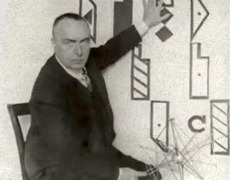Rudolph Laban (1879 – 1958, Hungary - U.K.).
 |
Rudolph Laban and his system for analysing and recording movement: Kynetography (Labanotation) |
As a choreographer, dancer, teacher and researcher, he achieves to spread his name and ideas widely: first through Europe, then to the United States and nowadays around the whole world.
Laban publishes several articles and renowned books that are still important references for dance theory and history. Some of his titles are: “Choreutics”, “The Mastery of Movement” and “Educational Modern Dance”.
He also invents labanotation (or kynetography Laban), which is the most complete and effective system for analyzing and writing movement, created till the time. By this, he opens a completely new theoretical frame for movement shape and quality analysis.
His thought includes the idea that human movement is the seat of life and that it expresses the social state of being. Therefore, dance would be a need of communitarian experience. He believes that educating individuals and groups by the means of movement can correct society.
He influences Mary Wigman, Kurt Joos, Albert Knust and almost all European modern dancers from the period between the two wars.
Anne Hutchinson Guest brings his movement notation system to the United States of America, where it is taught nowadays almost in every institution for high level dance education.
Rudolph Laban came up with a system for for recording dance movements. called Labanotation.
ReplyDeleteHe is considered a very productive person in the dance era. He publishes many books and articles which are important in dance theories and history.
He created the LABANOTATION - which is still used to this day. He has a completely new system for movement shape and quality. He has influenced Kurt Jooss.